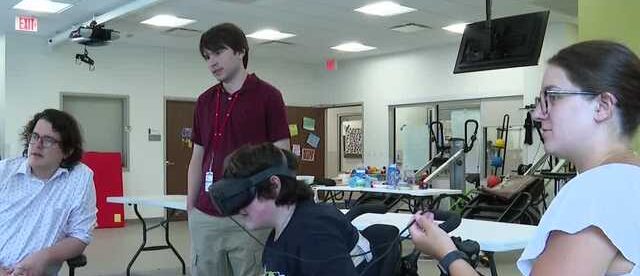Habit Camp: Innovative Virtual Reality Therapy Transforms Children’s Rehabilitation Experience
The University of Nebraska Medical Center’s Munroe-Meyer Institute has a program that uses technology and video games to help children with conditions like cerebral palsy. They employ virtual reality as a part of a two-week camp where kids engage in therapeutic play. Using headsets and controllers, campers play virtual reality video games that are specifically designed to target movements they need to practice, as guided by occupational and physical therapists.
The camp, called Habit Camp, offers children with cerebral palsy a playful environment to work on therapy. The games in virtual reality are challenging yet enjoyable, involving both hands and arms. The camp aims to see if this approach alters the children’s ability to use their arms and hands effectively. The innovative virtual reality therapy has shown positive results, with children like Connor, who has quadriplegic cerebral palsy, experiencing a change in their attitude towards therapy. Traditional physical therapy can be difficult for these children, but the virtual reality games provide a more motivating and enjoyable way for them to engage in therapeutic exercises.
In summary, the University of Nebraska’s Munroe-Meyer Institute uses virtual reality video games as a form of therapy for children with conditions like cerebral palsy. The games, played during a two-week camp, are designed to improve specific movements and are supervised by therapists. This approach has proven to be engaging and motivating for the children, making therapy more enjoyable and potentially more effective.
Source: KETV
Takeaways from Habit Camp
From this story, we can learn several valuable lessons:
1. Innovation in Therapy: The use of technology and innovation, such as virtual reality, can bring about novel and effective methods of therapy. This story highlights how thinking outside the box and incorporating technology into therapy programs can make the experience more engaging and impactful for patients.
2. Personalized Approaches: The story emphasizes the importance of tailoring therapy to individual needs. By designing virtual reality games that target specific movements and abilities that children with conditions like cerebral palsy need to practice, therapists can create a more personalized and effective rehabilitation program.
3. Positive Impact of Engagement: The engagement level of patients in their therapy can greatly affect the outcomes. In this case, the virtual reality games not only provided therapeutic benefits but also made the therapy enjoyable and fun. This increased engagement can lead to better adherence to therapy routines and more positive attitudes toward rehabilitation.
4. Motivation and Emotional Well-being: The story shows that when therapy is designed to be enjoyable and motivating, it can have a positive impact on emotional well-being. The children’s change in attitude towards therapy, as demonstrated by their enthusiasm and increased happiness, highlights how a positive approach can contribute to a better overall experience.
5. Changing Perspectives: Traditional therapy methods might not always be well-received, especially by children who associate them with pain and discomfort. By introducing innovative and enjoyable methods, like virtual reality games, perspectives on therapy can shift, making it a more eagerly anticipated and embraced part of their routine.
6. Collaboration and Teamwork: The story demonstrates the importance of collaboration between medical professionals, therapists, and technology experts. Working together, they developed a creative solution that benefits the children’s well-being and rehabilitation progress.
7. Empowerment and Confidence: The virtual reality games helped the children gain confidence in their abilities and motivated them to use their affected body parts. This empowerment can extend beyond the therapy room and positively impact their overall self-esteem and quality of life.
Overall, the story underscores how integrating technology, personalization, positive experiences, and collaboration can reshape the landscape of therapy and contribute to better outcomes for patients with unique needs.
This blog was written mostly using chatGPT, a potential tool for increased accessibility. Do you think this is an appropriate use of chatGPT? Why or why not? Let me know!


Leave a comment